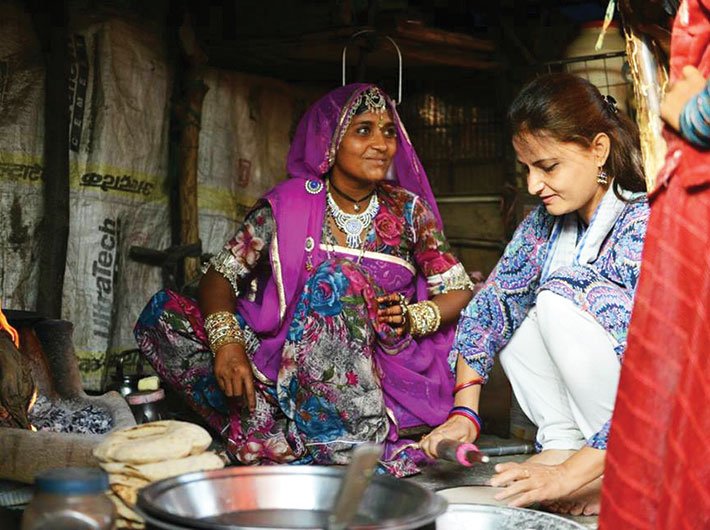A social media campaign aims to bridge gaps between communities by urging people to visit ‘people unlike us’
As Zahida Shabnam, a history professor and a television anchor, stepped into one of the ghettoes of the Gadiya Lohar community in Jaipur on a sunny Saturday recently, the women there did not seem too keen to let her mingle with them. In her blue cotton kurti, Shabnam seemed to typify to them an NGO worker. Prejudice raised its hood in minds of the women of the nomadic tribe, in their colourful ghaghras and vibrant Rajasthani ornaments.
“They were not too happy about the local NGO workers they were familiar with,” says Shabnam. These workers would just click pictures, make promises, but never return to do any real work, they complained to her when the ice was broken. For that to happen, Shabnam had to tell them that she was there to actually understand the lives of the Gadiya Lohars, to know the community and its culture better. On the spot she found hersef invited to a Gadiya Lohar wedding that was taking place the same day. The women gave her a black and golden ghaghra and some of their lighter ornaments.
Shabnam says she never imagined it would happen, but found herself joining the women in their traditional dance, with which the baraat begins. “In their community, women do not accompany the baraat, but the men asked me to join them if I wished. It was such a big gesture on their part. I did not go, as I didn’t have enough time. I stayed with the women instead, and helped them cook lunch, and mingled with their children,” she says. By the time she was leaving, such a good bond had been formed with them that the farewell was an emotional affair.
Zahida Shabnam was one of the several participants of social activist Shabnam Hashmi’s anti-segregation campaign, called ‘Mere Ghar Aa Ke Toh Dekho (Come, visit my home)’. The three-day campaign that kicked off on July 20 was launched to challenge preconceived notions about people belonging to another community, class, caste, religion, sexual orientation, language or region. Much like the theme of a recent TV commercial of a tea brand – in which the distance between the two neighbours of different faiths is shown being reduced by an invitation to tea – the campaign focused on reducing the distance between people from different backgrounds. Although the campaign was mostly propagated via social media, it received response from 18 states, including Gujarat, Maharashtra, Andhra Pradesh, Bihar, Uttar Pradesh and Jammu and Kashmir. Hashmi had urged people to meet at least one family from a different community so that they would understand it better. They were asked to videograph the visit or shoot pictures as a takeaway of their experience. A number of such videos have been uploaded on the Facebook page of the campaign.
Zahida Shabnam has a few takeaways from her visit. She told Governance Now her religion did not have any role to play during her visit to the nomadic community’s basti. “There was no reluctance or inhibition from either side once we started talking,” she says. “They were open people. I also got to see that there is a significant change in their thinking as well. Having been traditionally nomadic, they want to settle down now. They want to progress.” She says most children of the community attend school and are quite smart. Though it was the mukhiya’s son’s wedding that day, none of the children wanted to skip school. “I was positively surprised,” she says. “I asked one of the children to stay back and spend some time with me, but he left anyway.” The history professor says the visit helped shape her perception of the community.
According to Hashmi, the root of prejudice and bias is segregation. The idea of the campaign came up because she was perturbed by the hatred and violence perpetrated across the country. “I have extensively worked in Gujarat, and there, there are areas and there are borders. On one side there are Hindus, and on the other side, there are Muslims. This ghettoisation of both the communities is happening everywhere,” she says. However, through the campaign, an attempt has been made to reverse it.
Pooja Shah from Ahmedabad speaks of how these unmarked borders would have tripped her up in her very first steps towards a career. A fresh graduate, she has been offered a job in the Sarkhej area of the city, but her family and friends advised her against joining because her commute would take her through Juhapura, a Muslim-dominated area. She was told it was dangerous. “I decided I wouldn’t put an end to my career because of their mindset and prejudices about the Muslim community,” she says. “That’s why I decided to go to Juhapura as part of the ‘Mere Ghar Aa Ke Toh Dekho’ programme.”
But not everyone experienced the kind of opening-up that Shabnam or Shah did during their visits. In Gaddha colony, near Badarpur in Delhi, things did not go so well when 55-year-old Farida Khan, who runs a coaching centre for girl dropouts, visited a few Hindu families. Of late, there has been some disturbance in the area: a video-clip of a Muslim youth beating up a non-Muslim had gone viral over the past week and caused some communal tension.
Against this backdrop, the divide made itself very apparent. The campaigners had hoped that such conversations would take place over tea or snacks.
Lunch or dinner might be offered. In the process some of the barriers might fall. But Farida Khan discovered, to her chagrin, that the family she visited did not offer her even a glass of water. Perhaps it’s the socioeconomic profile of the area and the levels of education in the area that were to blame.
The hosts, native to Agra, live in a small one-storey house. In the narrow living room, where Khan sat on charpoy across from her hosts, the women of the house say they were all for peace and harmony between the communities. But prejudices were openly expressed. “Our block is very calm. It’s the D-block, where Muslims are in a majority, that is tense all the time,” one of the women told Khan as this reporter followed the conversation. Discussions veered into arguments on topics such as triple talaq and Uttar Pradesh chief minister Yogi Adityanath. Khan told her hosts that she objects to some of Yogi Adityanath’s statements only to run up against a vehement defence. Khan told this reporter that Muslims in the locality live in fear and under pressure. “I have educated my son and I’ve asked him to dress in modern clothes, but he refuses,” she says. “He wears a skullcap, keeps a beard. I’m scared he’ll be targeted someday for being a Muslim,” she said. On June 22, Junaid Ahmed, a 15-year-old boy, was stabbed to death on a train in Haryana: his assailants identified and mocked him as a Muslim because of his attire and set upon him because he was a “beef-eater” after all. Khan probably had that incident in mind.
Hashmi says she hasn’t seen any videos of participants not having a good experience with hosts, but she is aware of some videos from Maharashtra where the awkwardness was visible. “Mostly, the videos and stories we have received are positive and very interesting. A boy from Hyderabad realised he hasn’t visited his grandmother in a while; when he heard of our campaign, he went and met her and sent us a picture of his grandmother. It’s sweet how people are interpreting the message in different ways,” says Hashmi. Some participants have chosen to visit shelter homes and NGOs.
“This was thought up as a very small experiment,” says Hashmi. “We didn’t think it was going to change much, but we had given this call. And the response we received is very encouraging. Local organisations have picked it up, and they have asked us not to stop the campaign after three days, so we’re seeing if we could make it a weekly or bimonthly thing.”
According to Hashmi’s team, over 4,000 people from 18 states participated in the campaign. It ran successfully even in strife-torn Jammu and Kashmir. A team of three youths – Ishtiaque, Rafaquat and Rauf – interviewed Sikhs and Muslims from a Sikh-majority village called Turboni. They explored the relationship between the communities from both sides’ perspective. Rafaquat tells Governance Now, “We were really apprehensive about the campaign.
We were wondering if they’d understand what these random Muslim guys are talking about, and why. But our experience turned out to be really amazing. We saw real solidarity in the village, where a gurudwara and a masjid are on the same street.” Rafaquat says the feeling of concord between the communities was mutual. Perhaps such campaigns will help reinforce and highlight such feelings.
pranita@governancenow.com
(The story appears in the August 1-15, 2017 issue of Governance Now)

